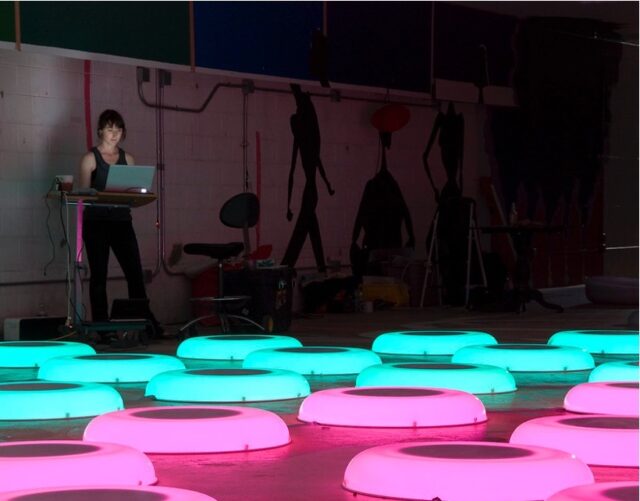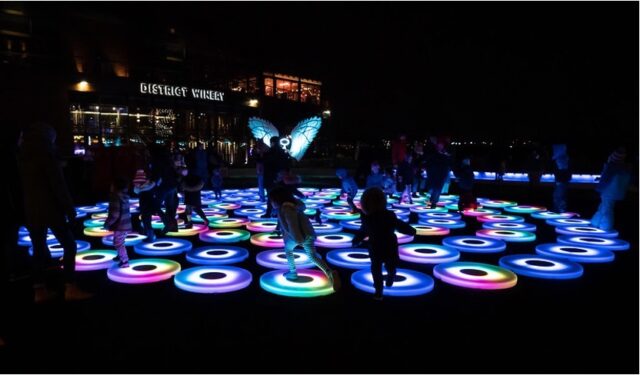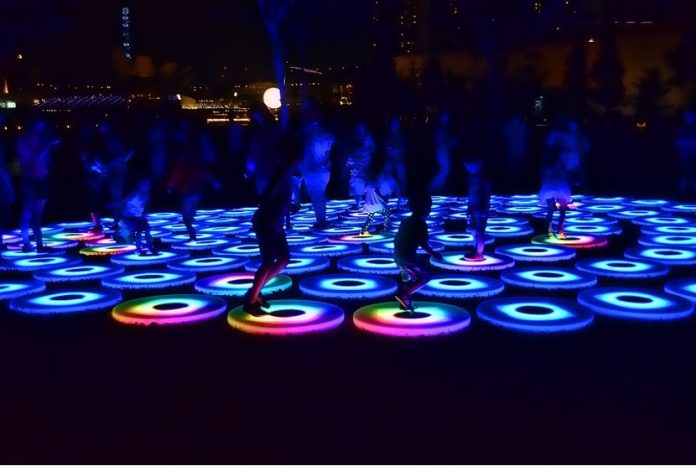“A giant canvas where you can paint and splash light collaboratively.” That is how Jen Lewin defines her light installation The Pool. Debuted in 2008, this art project created by Lewin, a Colorado-based digital artist, has been enjoying an international reputation with its journey around the world since 2008. With over 100 giant concentric pads that create swirling light and colour in accordance with participants’ movements, The Pool constructs an interactive environment that connects people and communities all around the world.
The Pool is a representative artwork in Lewin’s “Have Art will Travel Program”, an artistic effort that aims to generate immersive and interactive public art experiences across the global stage. Professionally trained as an architect, Lewin constantly seeks to integrate her art pieces into specific physical spaces in the natural environment to inspire the viewers into participation, bringing organic and feminine characteristics to her works of digital art.
A computerised social sculpture, The Pool demonstrates her aim to explore the transformative capacity of art in bringing together people and communities around the world. This interactive sculpture invites users to hop across over 100 glowing pads, creating a cacophony of light ripples and classical music pieces triggered by individual controllers installed in the pads. As users shift their weight or move from one pad to another, their actions are sensed by the pads, and visual and acoustic effects change accordingly. When different light ripples encounter and interact, they produce an infinite variety of colourful patterns.

Through The Pool, Lewin demonstrates her extraordinary ability to manipulate digital technologies deeply enmeshed in the production, circulation and distribution of digital art in an unprecedented way. To enhance the sense of immersion, The Pool provides both visual and acoustic enjoyment for viewers. The combination of visuality and acoustics coincides with Schafer’s notion of “soundmarks”, understood as the landmarks locating viewers in certain temporality and spatiality in the soundscape. The classical music pieces here function as a form of expression that serves subjective emotions, bringing a sense of being and belonging. Adopting such a sonic ecology, users can be fully immersed in a world created by their collaborative interactivity enabled by the use of digital technologies in the artistic production. With the assistance of technology, The Pool is also featured with strong resilience to different environment settings and potential external detriments from aggressive interactions and public use. Controllers in each pad allow for wireless communications between one and another and capturing the movements of users, with a waterproof shell protecting the mechanism inside. With this technological setting, no complicated technical setup or constant maintenance are needed, leading to higher efficiency in its global circulation and distribution. Thus, through this creative assemblage of technologies, Lewin has developed an unprecedented way to use digital technologies as mediums.
Another important dimension of the artwork relates to the element of audience interaction. Set up in the downtown area in metropolitans, The Pool took the best use of specific locations where people would physically gather and construct a digitally networked public sphere. When cheerful participants enter and skip into the visual and acoustic world created by The Pool, they also generated repeating social patterns for interpersonal connectivity. Lewin said she was surprised to see the behavioural similarity between different social groups, that is, one person will organise hundreds of strangers to simultaneously jump in the same direction at the count of three. This interpersonal connectivity driven by the shared experience of engaging with the installation can be understood as Habermas’s conceptualisation of the public sphere, in which people will physically gather and interact with a sense of imagined community. Furthermore, on social media platforms, The Pool as part of Lewin’s art project is often shared with the hashtag of “#womensart”, contributing to feminist discourses in a larger social agenda in the public sphere of the virtual world. This artwork, within the public spheres it constructs, opens up new possibilities for people to interact, communicate and most importantly, coming together.

All these features of this interactive sculpture indicate the categorisation of The Pool as a form of Post-Internet art, which is identified with blurred distinctions between physical and digital, bodily and virtual, artwork and everyday space, creator and audience. In the “Post-Internet” age, the essence of digital art is largely determined by the electric connectivity such as the internet and digital processes and manifested through material forms. Under this conceptualisation, The Pool demonstrates how Post-Internet art enables novel approaches of appreciation from the perspective of participatory aesthetics, defined as a cognitive framework in which imagination supports agency based on the public participation in artistically creative process. The installation could not be appreciated as art entire of its own. It is the creation of concurrent symphonies and splashes of light ripples through users’ agency that truly transcend The Pool from material “objects” as scattered pads to the platform allowing for artistic expressions and perceptual representations of the world, exemplified by the technologically mediated interactions of the participants, or in other words, the true creators.
Tracing back to the birth of the artwork, the idea of The Pool comes from Lewin’s experience of a camp trip to Australia she took when she was 18. While watching the tide went out at night, Lewin was amazed by the breathtaking scenery in which they could play around while the moonlight shone brightly on the sky with its reflection on the tide pools. In Lewin’s statement, the word “magical” was used to describe the moment when they were struck by the scene, feeling the sense of sublime—a notion in mechanic aesthetics referring to the affective sensation of awe realised through confrontation with external forces. Thus, with all the aforementioned dimensions, I argue that digital art by fusing visual and acoustic effects, participatory aesthetics and humane emotions offers a conduit for individuals to make sense of the world they have been living in and experiencing.
In conclusion, as a form of Post-Internet Art, The Pool manifests the philosophy of participatory aesthetics through a delicate manipulation of different technologies, both visually and acoustically. Considering the installation as a digital public art project, the unique artistic expression embedded in The Pool also contributes to the social connections in public spheres and conveying sublimed dimensions. Quoting a poem by a Chinese poet Guo Moruo, “The streetlights are on in a distance/as if numerous stars show; the bright stars loom in the above/as if numerous streetlights glow.” This interactive light pool by Lewin is just like a celestial market street falling from the sky onto the ground: a world of light in which users gathered, being captured and brought closer, decorating countless nights of various cities across the world.


